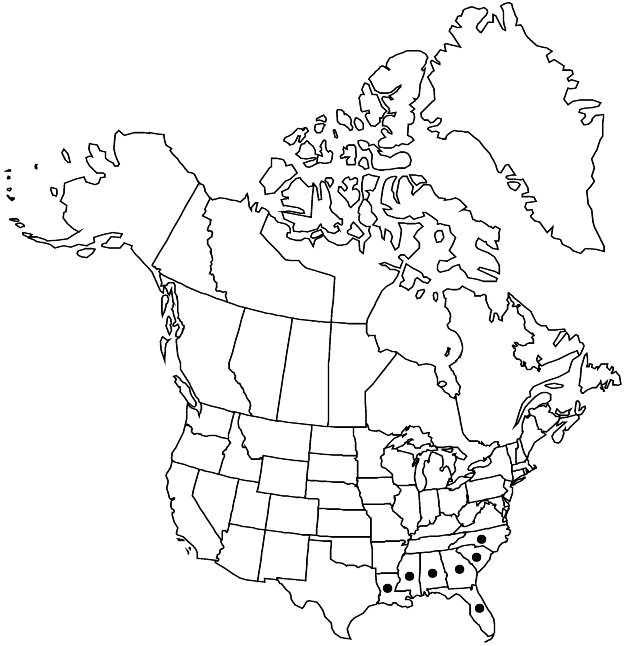Difference between revisions of "Gaylussacia nana"
Bull. Torrey Bot. Club 24: 443. 1897 ,.
FNA>Volume Importer |
FNA>Volume Importer |
||
| Line 10: | Line 10: | ||
|name=Gaylussacia frondosa var. nana | |name=Gaylussacia frondosa var. nana | ||
|authority=A. Gray | |authority=A. Gray | ||
| + | |rank=variety | ||
|publication_title=in A. Gray et al., Syn. Fl. N. Amer. ed. | |publication_title=in A. Gray et al., Syn. Fl. N. Amer. ed. | ||
|publication_place=2, 2: 396. 1886 | |publication_place=2, 2: 396. 1886 | ||
| Line 16: | Line 17: | ||
|name=Decachaena nana | |name=Decachaena nana | ||
|authority=(A. Gray) Small | |authority=(A. Gray) Small | ||
| + | |rank=species | ||
}} | }} | ||
|hierarchy=Ericaceae;Ericaceae subfam. Vaccinioideae;Gaylussacia;Gaylussacia nana | |hierarchy=Ericaceae;Ericaceae subfam. Vaccinioideae;Gaylussacia;Gaylussacia nana | ||
| Line 40: | Line 42: | ||
-->{{#Taxon: | -->{{#Taxon: | ||
name=Gaylussacia nana | name=Gaylussacia nana | ||
| − | |||
|authority=(A. Gray) Small | |authority=(A. Gray) Small | ||
|rank=species | |rank=species | ||
| Line 55: | Line 56: | ||
|publication year= | |publication year= | ||
|special status= | |special status= | ||
| − | |source xml=https://jpend@bitbucket.org/aafc-mbb/fna-data-curation.git/src/ | + | |source xml=https://jpend@bitbucket.org/aafc-mbb/fna-data-curation.git/src/f50eec43f223ca0e34566be0b046453a0960e173/coarse_grained_fna_xml/V8/V8_1043.xml |
|subfamily=Ericaceae subfam. Vaccinioideae | |subfamily=Ericaceae subfam. Vaccinioideae | ||
|genus=Gaylussacia | |genus=Gaylussacia | ||
Revision as of 22:25, 16 December 2019
Plants 2–6(–10) dm, forming small to extensive colonies; branches erect; young twigs pale green, densely hairy (hairs relatively short, curled). Leaves: petiole 2–3 mm; blade glaucous abaxially, dull green to yellowish green adaxially, ovate to oblong, 2.5–4 × 1–2 cm, subcoriaceous, base cuneate, margins entire, apex rounded to obtuse, surfaces glabrous or sparsely short-hairy (longer hairs ca. 0.1 mm) and sessile-glandular abaxially. Inflorescences drooping, 2–4-flowered, sometimes flowers solitary, bracteate, 1–2.5 cm, glabrous or pilose; bracts early-deciduous, leaflike or not, 5–6 mm, shorter than pedicels, glabrous, sessile-glandular. Pedicels 8–15(–20) mm, glabrous, sessile-glandular; bracteoles 1–2, 1–2.5 mm. Flowers: sepals 5, (glaucous), 1–1.2 mm, glabrous, sessile-glandular or not; petals 5, corolla greenish white, campanulate-conic, 3–5 mm, lobes deltate, ca. 1 mm; filaments 0.5–1 mm, ciliate; anthers included (tips barely exserted), 2.5 mm, thecae not divergent distally; ovary glabrous. Drupes juicy, sweet, dark blue, sometimes black, rarely white, glaucous, 5–8 mm diam., glabrous. Seeds 1.5 mm.
Phenology: Flowering late spring.
Habitat: Xeric to dry pine uplands and sand ridges, xeric to moist pine flatwoods and savannas, ecotones of seepage bogs and depressional wetlands, infrequently in wet soils
Elevation: 0-100 m
Distribution

Ala., Fla., Ga., La., Miss., N.C., S.C.
Discussion
Gaylussacia nana is a coastal plain endemic; it is distinguished by the glabrate and glaucous abaxial faces of leaves and the relatively large, glaucous to glaucescent fruits. Recent field work and herbarium studies have extended its known range.
Selected References
None.